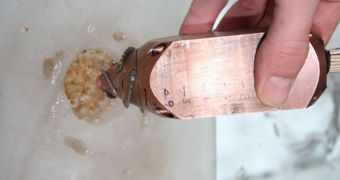The Jovian moon Europa is one of the most interesting space objects in our solar system, right alongside Mars, and Saturn's moon Titan and Enceladus. Many astronomers and astrobiologists believe that its thick ice layers hide an ocean of liquid water underneath, which made scientists tremble with excitement. A mission to Europa has already been proposed, but breaching tens or maybe even hundreds of miles of granite-hard ice is no easy feat. In order to solve this challenge, a group of experts now proposes using mole-like thermal drills, Space reports.
Until 2020, when a prospective mission to Europa is scheduled to launch, experts have sufficient time to set up all the specifics. The reason why such an instrument would be best suitable for exploring the icy moon is simple. The thermal component would heat the drill itself, ensuring an easy pass through the hard ice, whereas the rotating, drill-like component would make easy work of clearing the debris that result from the first process. The drill as a whole could be encased inside a penetrating module that would pierce into Europa's ice cover upon atmospheric descent.
“Penetrators are the most feasible, cheapest and safest option for a landing on Europa today, and the knowledge to build those is there,” explains scientist Peter Weiss, who is now a postdoctoral researcher at the National Center for Scientific Research (CNRS), in France. In a study published in the January issue of the esteemed scientific journal Advances in Space Research, the expert and his team present details of the proposed thermal drill. Researchers at the Hong Kong Polytechnic University and the Institut fuer Weltraumforschung in Graz, Austria, were also part of the investigation.
A collaboration for the future Europa Jupiter System Mission (EJSM) has already been set up between the European Space Agency (ESA) and NASA. Fortunately, the Russian Federal Space Agency (RosCosmos) and the Japanese Aerospace Exploration Agency (JAXA) are also showing interest in the agreement, and could join in at any time. Russia could be in charge of building the penetrators as, of all nations potentially involved, it is the only one to have ever designed such tools in the past.

 14 DAY TRIAL //
14 DAY TRIAL //